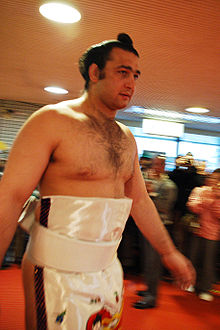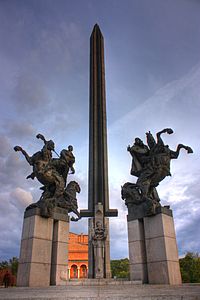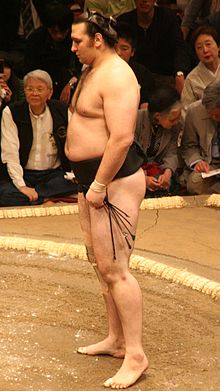- Kotoōshū Katsunori
-
琴欧洲 勝紀
Kotoōshū Katsunori
Personal information Born Kaloyan Stefanov Mahlyanov
February 19, 1983
Veliko Tarnovo, BulgariaHeight 2.03 m (6 ft 8 in) Weight 153 kg (340 lb; 24.1 st) Web presence website Career Heya Sadogatake Current rank Ōzeki Debut November, 2002 Highest rank Ōzeki (January, 2006) Yūshō 1 (Makuuchi)
1 (Jūryō)
1 (Makushita)
1 (Jonokuchi)Sanshō Outstanding Performance (2)
Fighting Spirit (3)* Career information is correct as of Nov 2011. Kotoōshū Katsunori (琴欧洲 勝紀) (born February 19, 1983 as Kaloyan Stefanov Mahlyanov, Bulgarian: Калоян Стефанов Махлянов, in Dzhulyunitsa, Veliko Tarnovo Province, Bulgaria) is a professional sumo wrestler or rikishi. He made his debut in 2002, reaching the top division just two years later. In 2005 he reached the rank of ōzeki or 'champion', the second-highest level in the sumo ranking system behind only yokozuna. On May 24, 2008, Kotoōshū made history by becoming the first European sumo wrestler to win an Emperor's Cup.[1] Upon the retirement of Kaiō, he became the longest serving active ōzeki.
Contents
Early career
He was originally a Greco-Roman wrestler, coached by his father, and by the age of 14 he had already won a European championship. He was accepted by the Bulgarian National Sports Academy where he majored in wrestling.[2] He hoped to compete for Bulgaria in the 2000 Olympic Games, but as his weight increased beyond the 120 kg upper limit, he switched instead to sumo.[3] He was recruited by Sadogatake stable, whose stablemaster was impressed by his filial duty of sending money home to his parents.[4]
Mahlyanov's professional sumo debut was in November 2002, starting in the lowest-ranked jonokuchi division. He was given the shikona of Kotoōshū, derived from his place of origin — koto, shared by all wrestlers at his stable, and ōshū, meaning Europe. (Following the September 2006 tournament, he changed one of the characters in his ring name, 州 becoming 洲, although the pronunciation, shū, is the same for both.) He posted kachikoshi (winning records in tournaments) throughout his early career, going 71-15 in the five divisions below the makuuchi top division. He reached makuuchi in September 2004, only 11 tournaments after his professional debut, the fastest rise since the introduction of the six tournaments per year system in 1958.[5]
Upon reaching the top division he had kachikoshi winning records for four consecutive tournaments, being promoted to sanyaku at the rank of komusubi before the March 2005 basho (sumo tournament). At the rank of komusubi, he made his first makekoshi (losing tournament) record, and was demoted to maegashira again before returning to the higher rank of komusubi after a strong 10-5 record in May.
Promotion to ozeki
In the July 2005 tournament Kotoōshū defeated Asashōryū for the first time with an overarm (uwatenage) throw, bringing to an end a run of 24 consecutive bout victories for the yokozuna. He also was the runner up in the tournament, winning an "outstanding performance" sanshō prize.
Kotoōshū was promoted to sekiwake for the following September tournament and won his first twelve bouts, finishing with an exceptional 13-2 runner up record and only losing the tournament victory after a play-off bout with Asashōryū. An 11-4 record in the final (November) tournament of 2005 was his third runner-up performance in a row and included another victory over the otherwise dominant Asashōryū. This led to his promotion to the rank of ōzeki on November 30, 2005. His three-tournament record (on which ōzeki promotions are based) was 36-9. His promotion coincided with the retirement of his stablemaster, former yokozuna Kotozakura.[2]
His promotion to ōzeki took only 19 tournaments from his professional sumo debut. Although he was not the youngest ozeki ever, this represents the most rapid rise for a wrestler entering sumo from the bottom jonokuchi division. (Certain experienced amateur wrestlers can be given dispensation to start in the third-highest makushita division.) He is also the first wrestler of European birth to hold the ōzeki rank, and one of only eight non-Japanese to have achieved it (the others being Konishiki, Akebono, and Musashimaru from Hawaii; Asashōryū, Hakuhō and Harumafuji from Mongolia; and Baruto from Estonia). Of those eight, four (Akebono, Musashimaru, Asashōryū and Hakuhō) later ascended to sumo's highest rank of yokozuna.
Ozeki career
After his promotion, Kotoōshū was somewhat restricted by a knee injury.[6] He was also criticised for relying too much on the henka technique– jumping to the side at the initial charge.[7] It is not considered to be a move worthy of someone at his high rank.
Kotoōshū managed only three double-figure scores in 2006, and none at all in 2007, only doing enough to maintain his rank. Shortly before the November 2007 tournament he dislocated his right knee in training. Clearly troubled by the injury he pulled out on the 7th day, the first time in his career that he has had to withdraw from a tournament. He preserved his ōzeki rank with a 9-6 score in January 2008. In the Osaka tournament of March 2008 he injured his left arm in a match with Kakuryu on the 4th day and withdrew on Day 9 with only two wins. There was speculation that he would be demoted to sekiwake in the following tournament in May.[8]
Needing eight wins to hold his rank in the May 2008 tournament, he won 12 consecutive bouts including dominating victories against yokozuna Asashoryu on the 11th day and yokozuna Hakuho on the 12th day. He was easily defeated by Aminishiki on the 13th day, but came back strong to defeat Ama on the 14th day, becoming the first European to win a top division championship.[9] His father was in the crowd to witness his victory.[9] He was also congratulated by the Bulgarian President Georgi Parvanov.[10]
Kotoōshū was unable to follow up his victory with a push for yokozuna promotion, producing scores of only 9-6 and 8-7 in the next two tournaments. In October 2008 he denied allegations by disgraced former wrestler Wakanohō that he had thrown matches against Kotoōshū in return for money, saying "I am saddened by this. It is all lies."[11] Wakanohō subsequently retracted his comments. He produced scores of 10-5 in the first two tournaments of 2009, the best record amongst his fellow ozeki. In the May 2009 tournament, he finished the tournament with a 9-6 score. However, he ended yokozuna Hakuho's 33-bout winning streak on the 14th day.[12] In July 2009 he was in contention for the yusho until the final day and finished runner-up with an impressive 13-2 score. He has not won more than ten bouts in a tournament since then. He pulled out of the May 2011 tournament on Day 11, citing a knee injury.[13] He returned in July and preserved his rank by securing his eighth win on Day 10 (the last bout of fellow ōzeki Kaiō's career), finishing on 9-6. However he withdrew once again in September after suffering five defeats in the first six days.[14]
Fighting style
Kotoōshū is a tall and rather light rikishi at 203 cm (6 feet, 8 inches) and 152 kg (334 pounds). In comparison, former yokozuna (grand champion) Akebono, at the same height, weighed 235 kg (517 pounds) at his peak. Yokozuna Asashōryū is about the same weight, but is only 184 cm in height. Kotoōshū primarily relies on so-called 'belt-throws' to win his sumo bouts. Recently he has typically preferred to take a hidari-yotsu (left-hand inside grip) on his opponent's mawashi (the belt that is fixed around the wrestler's waist), although he is right-handed and his overall profile still shows him preferring migi-yotsu (right-hand inside grip). He uses his long arms and quick footwork to counteract his high center of gravity and relatively light weight. His most common winning kimarite is yorikiri, the force out, followed by uwatenage, the outer arm throw.
Kotoōshū has remarked that his tournament victory was partially due to a weight gain of five kilos which enabled him to be sturdier against his opponents.[15]
In popular culture
- He is often dubbed the "David Beckham of sumo". Kotoōshū and another soccer player, Hristo Stoichkov, are the two most famous Bulgarian people in Japan.[16]
- He is noted for being a fan of the singer Ayaya, so much so that it prompted a commercial where they appear together (although a surprised Kotoōshū found out the day of filming that their parts were to be digitally melded). He often appears in TV commercials of yogurt products. This is because a Japanese dairy company, Meiji Dairies Corporation, sells a series of yogurt products under the name of Bulgaria Yogurt.
- He was chosen as a special judge for the 56th edition of Japan's annual Kouhaku Utagassen on 31 December 2005.
- He was made the Goodwill Ambassador to Japan by the European Union in April 2006.[17]
- He received the Order of Stara Planina, a prestigious Bulgarian award, in July 2009.
Family
In May 2009 Kotoōshū announced his engagement to 29 year old Asako Ando from Ichinomiya, Aichi Prefecture, whom he had dated for the previous five years.[18] They were married in February 2010, on St. Valentine's Day, at the New Otani Hotel in Tokyo, with around 600 guests including yokozuna Hakuho attending.[19]
He injured his right knee towards the end of the May 2010 tournament which required surgery and forced him to cancel plans to have a second wedding ceremony in Bulgaria, at the Evksinograd resort in Varna, during the European Sumo Championships.[20]
Tournament record
Kotoōshū Katsunori[21]
year in sumo January
Hatsu basho, TokyoMarch
Haru basho, OsakaMay
Natsu basho, TokyoJuly
Nagoya basho, NagoyaSeptember
Aki basho, TokyoNovember
Kyūshū basho, Fukuoka2003 West Jonokuchi #30
7–0
Champion
West Jonidan #25
6–1
West Sandanme #62
6–1
East Sandanme #8
6–1
East Makushita #33
5–2
West Makushita #21
5–2
2004 East Makushita #8
6–1
East Makushita #2
7–0
Champion
East Jūryō #10
10–5
East Jūryō #3
13–2
Champion
East Maegashira #14
9–6
West Maegashira #10
11–4
F2005 East Maegashira #4
9–6
West Komusubi
4–11
East Maegashira #5
10–5
East Komusubi
12–3
OEast Sekiwake
13–2–P
FEast Sekiwake
11–4
FO2006 West Ōzeki
10–5
West Ōzeki
9–6
West Ōzeki
8–7
West Ōzeki
8–7
West Ōzeki
10–5
West Ōzeki
10–5
2007 East Ōzeki
9–6
East Ōzeki
8–7
West Ōzeki
9–6
East Ōzeki
9–6
West Ōzeki
8–7
East Ōzeki
2–5–8
2008 West Ōzeki
9–6
East Ōzeki
2–7–6
West Ōzeki
14–1
East Ōzeki
9–6
West Ōzeki
8–7
West Ōzeki
8–7
2009 East Ōzeki
10–5
East Ōzeki
10–5
East Ōzeki
9–6
West Ōzeki
13–2
East Ōzeki
9–6
East Ōzeki
10–5
2010 East Ōzeki
9–6
West Ōzeki
10–5
West Ōzeki
9–6
East Ōzeki
10–5
West Ōzeki
10–5
East Ōzeki
8–7
2011 East Ōzeki
10–5
East Ōzeki
Tournament Cancelled
0–0–0East Ōzeki
3–8–4
West Ōzeki
9–6
West Ōzeki
1–6–8
East Ōzeki
–
Record given as win-loss-absent Top Division Champion Retired Lower Divisions
Sanshō key: F=Fighting spirit; O=Outstanding performance; T=Technique Also shown: ★=Kinboshi(s) P=Playoff(s)
Makuuchi ranks: Yokozuna — Ōzeki — Sekiwake — Komusubi — Maegashira
Divisions: Makuuchi — Jūryō — Makushita — Sandanme — Jonidan — JonokuchiSee also
- Glossary of sumo terms
- List of sumo tournament winners
- List of sumo tournament second division winners
- List of active sumo wrestlers
References
- ^ "Kotooshu becomes first European to win sumo title". Associated Press. 2008-05-24. http://afp.google.com/article/ALeqM5h3B2FpsFF0_ODzxuuFenl6rz2b-A. Retrieved 2008-05-24.
- ^ a b "Kotooshu Talk Asia Interview". CNN International.com. 2007-03-06. http://edition.cnn.com/2007/WORLD/asiapcf/03/03/talkasia.kotooshu.script/index.html. Retrieved 2008-05-22.
- ^ "Is Kotooshu destined for sumo greatness?". Japan Today. 2005-09-29. http://google.com/search?q=cache:WddAjLjb7h8J:archive.japantoday.com/jp/kuchikomi/373/all+kotooshu+olympic+2000&hl=en&ct=clnk&cd=11&gl=uk&client=firefox-a. Retrieved 2008-05-26.
- ^ Onishi, Norimitsu (2003-08-03). "Fears That the New State of Sumo Defiles Tradition". The New York Times. http://query.nytimes.com/gst/fullpage.html?res=9F05E7D9103EF930A3575BC0A9659C8B63&sec=&spon=&pagewanted=all. Retrieved 2008-06-19.
- ^ "2008 May Grand Sumo Tournament Banzuke Topics". Japan Sumo Association. April 2008. http://sumo.goo.ne.jp/eng/hon_basho/topics/banzuke_besshi.html#2. Retrieved 2008-04-28.
- ^ Hardy, James (2008-05-25). "Euro-phoria for Kotooshu / Bulgarian bags Summer tournament title, becomes 1st European to capture Emperor's Cup". Daily Yomiuri. http://www.yomiuri.co.jp/dy/sports/20080525TDY24303.htm.
- ^ "Normal service resumed at the Nagoya Basho". The Japan Times Online. 2007-07-24. http://search.japantimes.co.jp/cgi-bin/ss20070724mb.html. Retrieved 2007-07-24.
- ^ "How firm is the reign of the Mongolians?". The Japan Times. 2008-05-08. http://search.japantimes.co.jp/cgi-bin/ss20080508mb.html. Retrieved 2008-06-14.
- ^ a b "Bulgarian Kotooshu becomes first European to win an Emperor's Cup". International Herald Tribune. 2008-05-24. http://www.iht.com/articles/ap/2008/05/24/sports/AS-SPT-SUM-Japan-Roundup.php. Retrieved 2008-05-24.
- ^ "Bulgaria Sumo Wrestler Kotooshu Wins Emperor's Cup". Sofia News Agency. 2008-05-24. http://www.novinite.com/view_news.php?id=93431. Retrieved 2008-05-24.
- ^ Wilson, Steve (2008-10-06). "Kotooshu, ‘sumo’s David Beckham’, accused of bout-fixing by fellow wrestler". London: Daily Telegraph. http://www.telegraph.co.uk/sport/insport/3145416/Kotooshu-sumos-David-Beckham-accused-of-bout-fixing-by-fellow-wrestler-Sumo-Wrestling.html. Retrieved 2008-10-06.
- ^ "Hakuho, Asa defeated; title still up for grabs". The Japan Times. 2009-05-24. http://search.japantimes.co.jp/cgi-bin/ss20090524b1.html. Retrieved 2009-05-24.
- ^ Smaal, Rob. "SUMO/ Hakuho passes 'test' to claim 7th straight tournament". Asahi Shimbun. http://www.asahi.com/english/TKY201105230175.html. Retrieved 24 May 2011.
- ^ "Ozeki hopeful exhibits toughness". Japan Times. 18 September 2011. http://search.japantimes.co.jp/cgi-bin/ss20110918b1.html. Retrieved 22 September 2011.
- ^ "Bulgarian Kotooshu crowned king of sumo in historic tournament victory". International Herald Tribune. 2008-05-25. http://www.iht.com/articles/ap/2008/05/25/sports/AS-SPT-SUM-Japan-Roundup.php. Retrieved 2008-05-25.
- ^ Nikkan Sports, 2004-06-21 Feature : Bulgarian Stoichkov (Japanese) Retrieved 2010-08-12
- ^ "Rare woman in sumo wrestling made Bulgaria's Kotooshu into superstar". AFP. 2008-05-17. http://afp.google.com/article/ALeqM5i3ZEH6TAh5GqhpBetUBvvBLjE7Nw. Retrieved 2008-05-22.
- ^ "Bulgarian ozeki Kotooshu announces engagement". Kyodo News. 5 May 2009. http://home.kyodo.co.jp/modules/fstPhotos/index.php?photoid=35117. Retrieved 5 May 2009.
- ^ "Bulgarian sumo wrestler Kotooshu married on St Valentine's Day". Sofia Echo. 15 February 2010. http://www.sofiaecho.com/2010/02/15/858270_bulgarian-sumo-wrestler-kotooshu-married-on-st-valentines-day. Retrieved 17 February 2010.
- ^ "Injury Ruins Kotooshu's Surprise Wedding at European Contest". Sofia News Agency. http://www.novinite.com/view_news.php?id=116556. Retrieved 26 May 2010.
- ^ "Rikishi in Juryo and Makunouchi". szumo.hu. http://www.szumo.hu/sekitori/Kotooshu.html. Retrieved 2007-07-24.
External links
- Official blog (Japanese)
- Kotooshu - Profile, Results, Pictures, Guest Book
- Nihon Sumo Kyokai - Biography
Capital: Veliko Tarnovo Cities 
Villages Arbanasi, Balvan, Belchevtsi, Belyakovets, Bijovtsi, Boychevi kolibi, Boychovtsi, Bochkovtsi, Boyanovtsi, Brankovtsi, Bukovets, Devetatsite, Dechkovtsi, Dimitrovtsi, Dimovtsi, Dichin, Doynovtsi, Dolen Enevets, Dolni Damyanovtsi, Dunavtsi, Emen, Gabrovtsi, Gashtevtsi, Golemanite, Goranovtsi, Goren Enevets, Hotnitsa, Ivanovtsi, Ilevtsi, Kapinovo, Kisyovtsi, Kladni dyal, Klashka reka, Kutsarovtsi, Lagerite, Ledenik, Malki chiflik, Malchovtsi, Margovtsi, Mindya, Mishemorkov han, Momin sbor, Natsovtsi, Nikyup, Novo selo, Osenarite, Piramidata, Plakovo, Pojernik, Popovtsi, Prisovo, Prodanovtsi, Pushevo, Pchelishte, Purovtsi, Radkovtsi, Raykovtsi, Rashevtsi, Resen, Rusalya, Ruskovtsi, Samovodene, Samsiite, Seymenite, Semkovtsi, Shemshevo, Sheremetya, Shodekovtsi, Suha reka, Surnentsi, Terziite, Todorovtsi, Tseperanite, Tserova koria, Tsonkovtsi, Ushevtsi, Velchevo, Vetrintsi, Vilare, Vodoley, Voneshta voda, Voynezha, Vuglevtsi, Vurlinka, Yalovo, YovchevtsiHistory Rebellion of Asen and Petar, Siege of Tarnovo, First and Second Tarnovo Uprising, Tarnovo ConstitutionLandmarks Yantra River, Emen canyon, Trapezitsa, Hotnitsa fall, Pass of the RepublicCulture Arbanasi Monastery, Church of SS. Peter and Paul, Church of St Demetrius, SS. Forty Martyrs Church, Patriarchal Cathedral, Tsarevets, Veliko Tarnovo University, Hotnitsa Grandmas, Nicopolis ad IstrumNotable people Saint Evtimiy, Gregory Tsamblak, Petko Slaveykov, Stefan Stambolov, Vasil Zlatarski, Krassimir Balakov, Maria Ilieva, Kotoōshū, Grigor Nachovich, Dimitar Grekov, Emiliyan Stanev, Ilarion Dragostinov, Mitkaloto, Theodosius of Tarnovo, Filip Totyu1Towns are in bold. Categories:- 1983 births
- Living people
- Bulgarian expatriates in Japan
- Bulgarian sumo wrestlers
- Ōzeki
- People from Veliko Tarnovo
Wikimedia Foundation. 2010.


